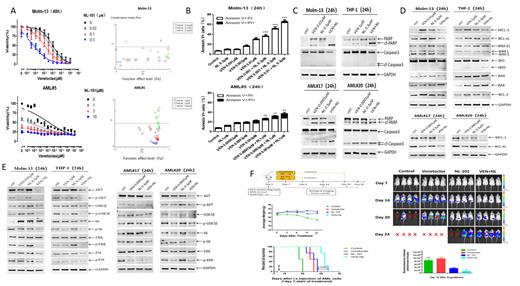Background
Acute myeloid leukemia (AML) is a kind of malignant clonal disease originating from hematopoietic stem cells with strong heterogeneity,with the highly recurrence rate and mortality rate.Although the application of hematopoietic stem cell transplantation and new targeted drugs has improved the prognosis of some patients in recent years, chemotherapy is still the most important treatment for AML. 50-80% of AML patients eventually relapsed after CR, with a low remission rate after relapse.There are reports that BCL-2 overexpression is a clinical feature of human hematologic malignancies that exacerbates the malignant state and drives apoptosis resistance phenotypes.Therefore, how to reduce treatment-related toxic and side effects and overcome tumor cell drug resistance is a hot and difficult topic in current AML treatment.
Venetoclax (ABT-199) is an oral, selective Bcl-2 inhibitor. It showed strong anti-leukemia activity in preclinical stage, but its clinical efficacy as a single drug for AML was limited.Nl-101 (also known as EDE-S101)is a new small molecule compound formed by covalently linking the DNA damage core group of Bendamustine hydrochloride with the inhibition core group of histone deacetylase of the histone inhibitor Volinostat (also known as SAHA).Our previous study found that NL-101 single drug can reduce tumor load and prolong survival of AML mice in vivo.In this study, we used Venetoclax in combination with NL-101 to understand its efficacy and safety in vitro and in vivo, and to explore the synergies and mechanisms of action between the two drugs, providing new effective options for the treatment of AML patients.
Purpose
To explore the efficacy of Bcl-2 inhibitor Venetoclax (ABT-199) and a novel small molecule compound NL-101 in the treatment of acute myeloid leukemia(AML) and the related mechanisms.
Experimental Design
AML cell lines and primary patient samples were collected and used for cell proliferation assay. MTS colorimetric assay was used to determine the effect of Venetoclax alone or in combination with NL-101 on the growth of AML cells,the combination index (CI) was calculated to evaluate the synergistic effect of the two drugs. Cell death induced by Venetoclax alone or in combination with NL-101 was analyzed by Annexin V-FITC/ Propyl -iodide staining and flow cytometry. Western blot was used to analyze the protein expression levels of MAPK/ERK, PI3K/AK/GSK pathway members and BCL-2 family members.The MV4-11-derived xenograft mouse model was used to assess in vivo efficacy of the combination of venetoclax and NL-101.
Results
Venetoclax alone and in combination with NL-101 can inhibit the growth of AML cell lines and primary cells to a certain extent, and the combination of drugs has a synergistic effect. Venetoclax combined with NL-101 effectively synergistically induced apoptosis in AML cell lines and primary patient samples. Venetoclax combined with NL-101 can down-regulate the expression of pro-survival proteins in the Bcl-2 family, such as McL-1, Bcl-2, and Bcl-XL, and up-regulate the expression of pro-apoptotic proteins, such as BIM, BID, and BAX/BAK. Phosphorylated ERK, AKT, and JNK expressions were eliminated by venetoclax in combination with NL-101. In vivo results suggest that Venetoclax combined with NL-101 has the potential to treat AML.
Conclusions
Venetoclax combined with NL-101 can synergistically inhibit the growth and promote apoptosis of AML cell lines and primary AML cells. In vivo experiments demonstrated that Venetoclax combined with NL-101 can synergistically reduce tumor load and prolong survival time in AML mice. These results suggest that Venetoclax in combination with NL-101 is effective in the treatment of acute myeloid leukemia.
Disclosures
No relevant conflicts of interest to declare.


This feature is available to Subscribers Only
Sign In or Create an Account Close Modal